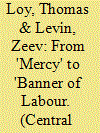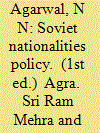| Srl | Item |
| 1 |
ID:
184421


|
|
|
|
|
| Summary/Abstract |
This paper presents the development and transformations of Bukharan Jewish newspapers and periodicals (1910–38) and situates them in the broader Central Asian mediascape. Over a period of 30 years, the Bukharan Jewish press was transformed from a pioneering privately owned enterprise that served the needs of the Jewish communities throughout Central Asia to one owned and regulated by the Soviet state, serving as a tool to transmit propaganda and to shape and educate a predefined ‘national minority group’. The paper argues that the introduction of a Bukharan Jewish press in 1910 was intended to create a modernized language and ethnic awareness among the Jews of Central Asia. In the 1930s, Bukharan Jewish newspapers and journals were radically Sovietized and finally shut down by the state. From then until the collapse of the Soviet Union, no Bukharan Jewish publications appeared in the bloc and the existence of a distinct Central Asian Jewish identity was largely ignored. This case study sheds light on Tsarist and Soviet minorities’ policies and helps us to better understand the various changes experienced and the cultural adaptations made by many ‘minorities’ of Central Asia in the Age of Colonialism.
|
|
|
|
|
|
|
|
|
|
|
|
|
|
|
|
| 2 |
ID:
136293


|
|
|
|
|
| Summary/Abstract |
For a revolution over “culture,” remarkably little has been said about the Cultural Revolution culture itself, and even less about the apolitical, private art produced underground. This article explores this apolitical, private art, arguing that it was a “rebellion of the heart” against the state’s ruthless destruction of the private sphere. Mao’s Party-state drastically fragmented families, moulding socialist subjects through “revolution deep down into the soul.” Paintings of (broken) homes and interiors, flowers, and moonlight articulate lived experiences of the revolution while silently reinventing a private refuge for the body and soul to subsist beyond state control. Defying orthodox revolutionary mass culture, this apolitical art articulated private experience and created a private inner world for a new form of modern subjectivity, while generating community and human solidarity against relentless class struggle and alienation.
|
|
|
|
|
|
|
|
|
|
|
|
|
|
|
|
| 3 |
ID:
027783


|
|
|
|
|
| Edition |
1st ed.
|
| Publication |
Agra, Sri Ram Mehra and company., 1969.
|
| Description |
xii, 452p.Hbk
|
|
|
|
|
|
|
|
|
|
|
|
Copies: C:1/I:0,R:0,Q:0
Circulation
| Accession# | Call# | Current Location | Status | Policy | Location |
| 003720 | 947/AGA 003720 | Main | On Shelf | General | |
|
|
|
|